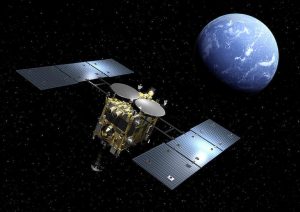Launched in 2014, JAXA's Hayabusa2 is a spacecraft with a 6-year mission to intercept and sample the Class C asteroid Ryugu-162173, and return samples to Earth. The spacecraft departed Ryugu in December of 2019, and returned samples to Earth December 5, 2020.
ASU School of Earth and Space Exploration Director Meenakshi Wadhwa is a member of the Hayabusa2 Initial Analysis Team for Chemistry.

Hayabusa2's scientific instrumentation includes a near infrared spectrometer (NIRS3), thermal infrared imager (TIR), multiband imager (ONC-T), laser altimeter (LIDAR), separation camera (DCAM), and MASCOT, a multi-instrument lander consisting of MicrOmega infrared microscope, magnetometer, radiometer, and wide-angle camera.
The spacecraft arrived at Ryugu in June of 2018, and deployed MINERVA-II1 (Micro-Nano Experimental Robot Vehicle for Asteroid) onto its surface that September. MINERVA-II1 contained 2 hopping rovers, HIBOU and OWL, to photograph Ryugu's surface and log temperature data. The MASCOT lander, also designed to move by hopping, was deployed in October of 2018, and collected data on the asteroid's composition.
In early 2019, Hayabusa2 fired the Small Carry-on Impactor (SCI), an explosive projectile that created a crater on Ryugu, exposing sub-surface asteroidal material for sampling.



